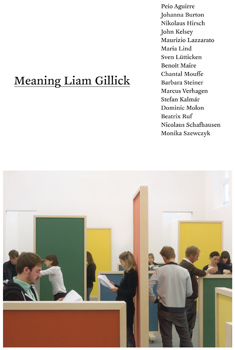
Meaning Liam Gillick
Edited by Monika Szewczyk
Paperback ISBN 978-0-262-51351-7 220 pp, 43 illus.
Publication: June 2009
The first critical reader on the artist's work.
With essays by Peio Aguirre, Johanna Burton, Nikolaus Hirsch, John Kelsey, Maurizio Lazzarato, Maria Lind, Sven Lütticken, Benoît Maire, Chantal Mouffe, Barbara Steiner and Marcus Verhagen.
Liam Gillick (b. 1964) is a New York and London-based artist who emerged in the 1990s in the midst of paradigmatic political and cultural change. In the past two decades, he has developed a highly influential artistic practice around a discursive model that complicates object production and raises key social questions. This reader brings together diverse theorists, critics, historians, curators and artists to address Gillick's work and its contexts.
Questions of discourse dominate the first four contributions to the book. Peio Aguirre develops his thinking around the "poetics of social forms," drawing dialectical relations between Gillick's screen structures, designs, collaborations and the social imaginary of his writings, treating the artist's praxis as a "whole," albeit a necessarily elusive one. Sven Lütticken also attends to elusiveness – Gillick's as well as artist-writers' such as Dan Graham, Robert Smithson, Marcel Broodthaers and Donald Judd – but stresses two conflicting impulses at play in (not) making sense: a critical strategy and an economic imperative. Marcus Verhagen focuses on Gillick's collection of critical writing, Proxemics: Selected Writings (1988-2006), and develops key distinctions: between Gillick's discourse and that of Nicolas Bourriaud; and between these two sometime collaborators and the art historian and critic Claire Bishop, who took up Chantal Mouffe and Ernesto Laclau's notion of "antagonism" to critique Bourriaud's notion of "relational aesthetics" alongside the art of Gillick and Rirkrit Tiravanija. John Kelsey combines Foucault's use of the Ancient Greek term parrhesia -- a public speaking of truth, even in the face of death -- with Deleuze's notion of "indirect discourse," to question the political underpinnings and truth claims in Gillick's "Volvo" fiction.
At their core of the next three essays lie the political and ideological problems of defining difference -- which Gillick repeatedly nominates as a key concern – and of practicing differentiation. Barbara Steiner distinguishes corruption, corruptibility, and complicity with market forces and institutional powers. Chantal Mouffe reviews her notion of radical democracy and antagonism drawing nuanced connections and distinctions between Gillick's praxis and the theories she has developed (also with Ernesto Laclau). Johanna Burton's essay notes a lack of specificity with regard to Gillick's deployment of the term "difference" and goes on to develop an instance of feminist difference rooted in enthusiasm.
Maria Lind considers kitchens. She takes up this ubiquitous feature of every modern home as a historical nexus, both of the post-World War II ideological battles over planning and speculation, and of several gender-coded modes of production. Further questioning the grounds of practice, Nikolaus Hirsch, considers the changing status of the architectural model as a thought-paradigm and as a thing for forging politics.
The last two essays tarry with the operative abstractions of temporality and historical consciousness. Maurizio Lazzarato, whose theorization of immaterial labor has been especially influential for Gillick, contributes notes on the current economic crisis. He focuses on how the logic of debt within neoliberal capitalism, where tomorrow's earnings are consumed in today's purchases, becomes a tool to block possibilities of thinking alternative futures. Benoît Maire's links the free floating time found in Gillick's fictional writings to developments in continental philosophy, using a complex notion of the screen as a device for mediating social relations in a post-historical time.
Meaning Liam Gillick is published by the partners organizing the ongoing survey exhibition: Liam Gillick: Three Perspectives and a Short Scenario
Witte de With Center for Contemporary Art, Rotterdam, 19.01.08 - 24.03.08
http://www.wdw.nl
Kunsthalle Zürich, 26.01.08 – 30.03.08
http://www.kunsthallezurich.ch
Kunstverein München, 27.09.08 –16.11.08
http://www.kunstverein-muenchen.de/gillick
Museum of Contemporary Art, Chicago, 10.10.09 - 10.01.10
http://www.mcachicago.org
Co-published and distributed by:
The MIT Press
http://mitpress.mit.edu